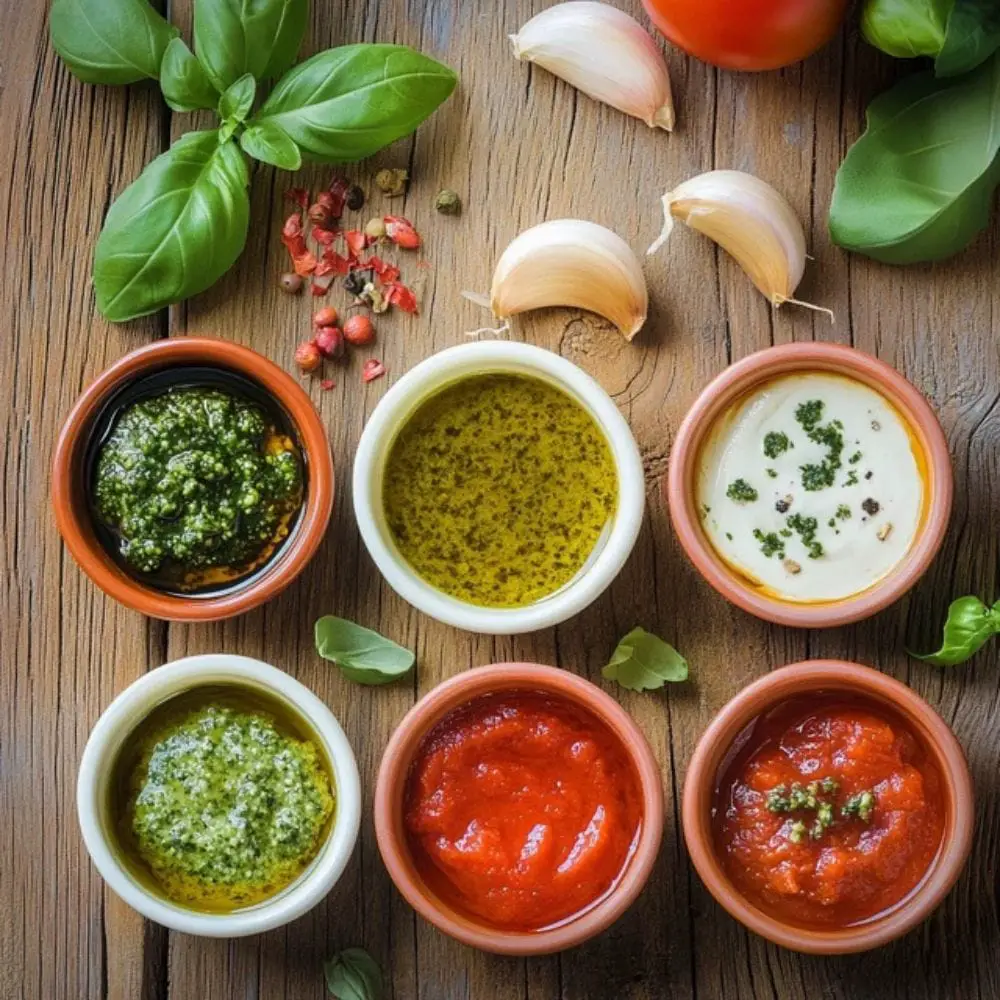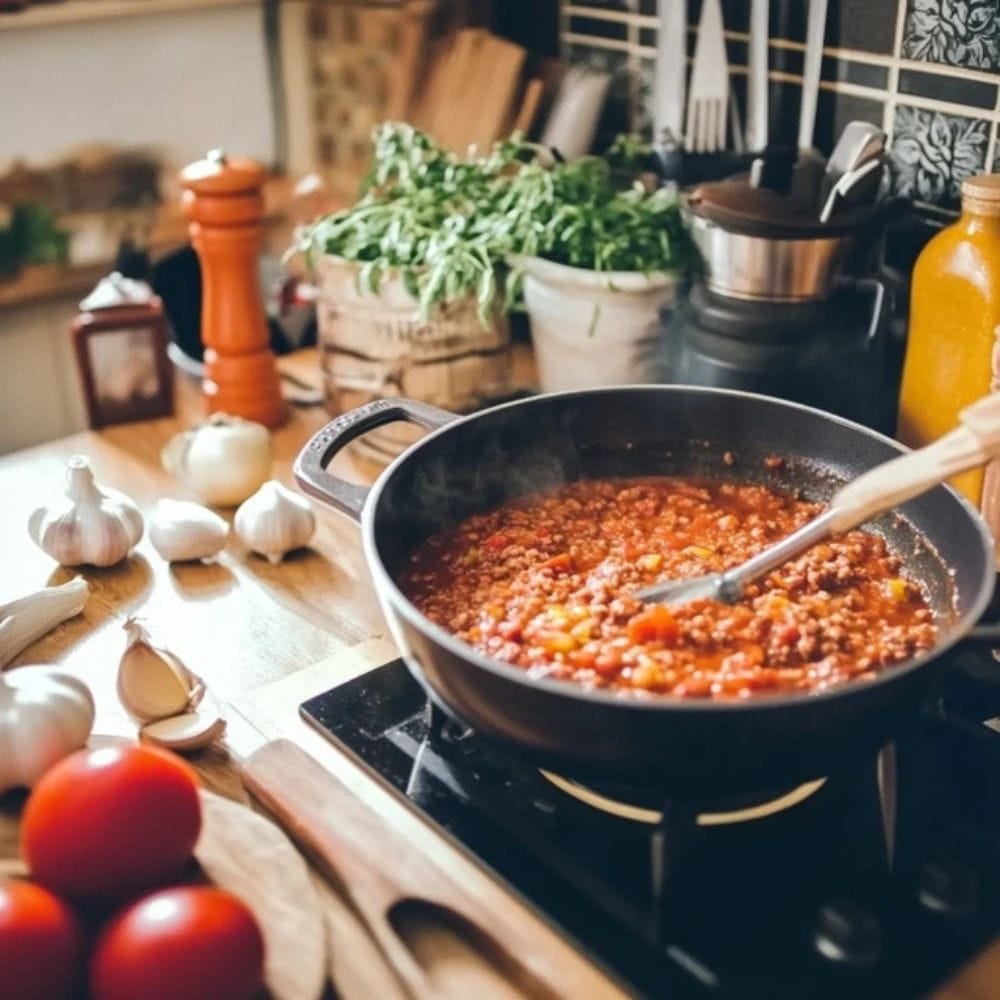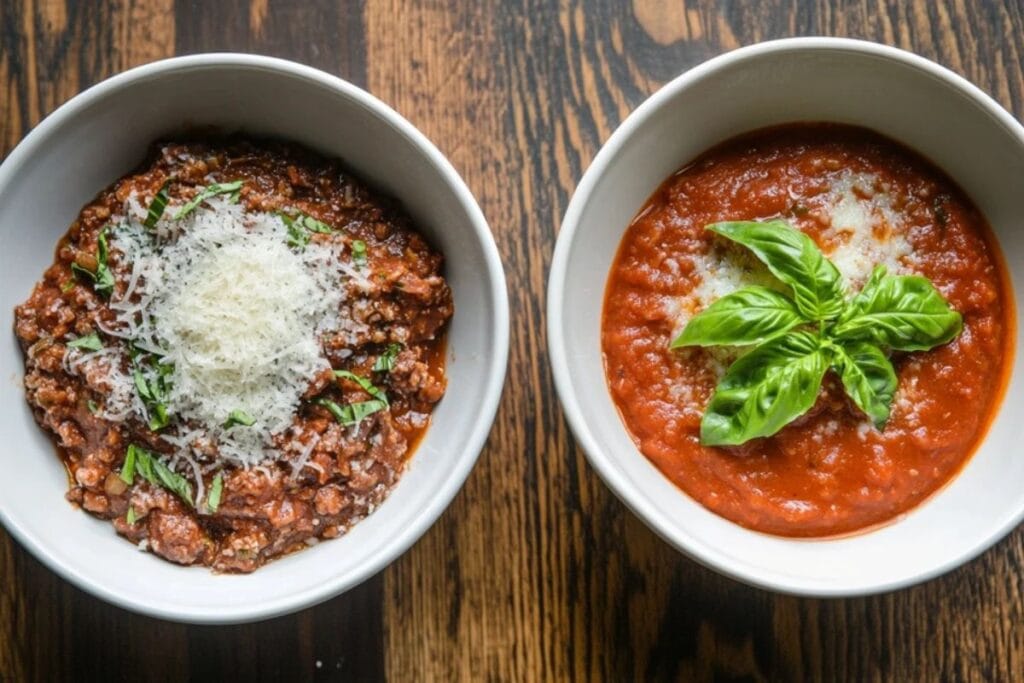I’ve spent many afternoons stirring big pots in my Southern kitchen. Folks often ask about the difference between sauce and ragù, especially when they want that rich taste of Italy. Sauce can be any flavorful liquid or semi-liquid that coats food. Ragù leans on hearty meats and slow cooking. Both have their place at the table. Yet one is meatier, and the other is more general.
There’s a soft spot in my heart for tomato-heavy sauces and a deep appreciation for meat-based ragù. Difference between sauce and ragù pops up in many old-country recipes. So I’m here to explain these Italian delights in plain words. Each has its own charm. And each can turn simple pasta into something special.
Defining ‘Sauce’ in Italian Cooking

General Characteristics of Sauces
Many sauces in Italian cooking are built on tomatoes, wine, or cream. They can be smooth, chunky, or something in between. Some use olive oil and herbs to create light, simple flavors, while others include onions and garlic for a savory touch. Additionally, cooks often adjust the seasonings to suit the final dish. This is how layers of flavor develop in the pot.
Some people assume all Italian sauces include tomatoes, but that’s not always true. A sauce could be a light mix of olive oil, lemon juice, and parsley, or it might be a rich cream sauce that coats fettuccine. Meanwhile, the difference between sauce and ragù becomes clear here, as ragù focuses on meat. Sauce, on the other hand, stays a broader concept in the kitchen.
Common Ingredients in Traditional Sauces
Tomatoes, basil, oregano, and onions show up in many classic sauces. Garlic often joins in, along with a splash of wine for depth. Olive oil plays its role too. For more insights on traditional sauce ingredients, visit history of these traditional sauce ingredients. Most sauces finish with salt and pepper, though some cooks add a pinch of sugar to balance acidity.
| Common Ingredient | Flavor Contribution |
|---|---|
| Tomatoes | Tangy base |
| Onions | Sweet-savory depth |
| Garlic | Sharp earthiness |
| Basil | Light herb note |
| Olive Oil | Smooth richness |
Understanding ‘Ragù’: A Meat-Based Italian Sauce
Origins of Ragù in Italian Cuisine
Ragù has roots in sturdy home cooking. Some say it began as a way to stretch small amounts of meat with herbs and tomatoes. People found that simmering for hours created a thick, hearty sauce. Because of this, ragù stands apart. For a deeper look into the history of ragù in Italian cuisine, see this helpful resource. Ragù remains a proud staple across many regions.
Key Ingredients of Ragù
Most ragù starts with meat, often ground beef or pork. Some versions add pancetta for a smoky note. Onions, carrots, and celery form the backbone, though tomatoes play a smaller role than many folks think. Still, a splash of red wine can deepen the taste. Then the sauce simmers until it thickens. A ragù feels hearty and clings to pasta with real heft.
Regional Variations of Ragù

Italy is famous for its regional takes on ragù. In Bologna, folks add milk to create a creamier sauce. Down south, cooks might skip dairy and use a bit more tomato. Some ragùs include sausage, while others feature chopped beef. Also, cooking times vary from region to region. Yet each ragù holds to the idea of meat-based richness. For more on regional ragù variations, read this account.
| Region | Key Ragù Trait |
|---|---|
| Bologna | Creamy with milk |
| Naples | More tomato, sometimes sausage |
| Tuscany | Often uses wild game |
Comparing Sauce and Ragù: Key Differences
Ingredient Composition
The fundamental difference between sauce and ragù lies in their core ingredients and balance of flavors. A basic sauce typically consists of tomatoes, garlic, and herbs, often enriched with oil, cream, or broth. This results in a bright, fresh taste that can be adjusted with various seasonings. On the other hand, ragù is a meat-based sauce where tomatoes play a supporting role rather than taking center stage. Many traditional ragù recipes include only a small amount of tomato, while others incorporate more, but meat remains the dominant element. Additionally, ragù frequently features aromatic vegetables such as onions, carrots, and celery, which contribute to its depth and complexity.
- Sauce: Primarily tomato-based, with added herbs and seasonings.
- Ragù: Meat-heavy, with a minor tomato presence and aromatic vegetables.
The contrast between these two approaches leads to distinct culinary experiences. A simple tomato sauce delivers a fresh, zesty profile, making it ideal for dishes requiring a light and tangy touch. Conversely, ragù offers a deeper, earthier taste, providing a rich and hearty element to meals. Many people mistakenly assume that sauce and ragù are interchangeable, but the difference becomes unmistakable when you compare their textures, cooking processes, and final flavors.
Preparation Techniques for Sauce and Ragù
One of the most significant distinctions between sauce and ragù emerges in their cooking methods. Simple tomato-based sauces can come together quickly—often in just 20 to 30 minutes—by sautéing garlic, adding tomatoes, seasoning, and simmering briefly. This technique preserves the tomatoes’ brightness while keeping the sauce relatively light.
Ragù, in contrast, requires a slow-cooking approach that allows flavors to develop gradually. The process usually involves browning meat first, adding a splash of wine for depth, incorporating vegetables, and then letting everything simmer over low heat. Depending on the recipe, ragù might cook for one to two hours or even longer. This extended simmering period thickens the sauce, melds the ingredients harmoniously, and deepens the flavor.
- Sauce Preparation:
- Quick to make (20-30 minutes).
- Bright, fresh taste.
- Requires minimal ingredients and effort.
- Ragù Preparation:
- Slow cooking process (1-3 hours).
- Rich, deep flavor that improves over time.
- Requires browning meat, adding wine, and slow simmering.
Many Italians believe that time is the secret ingredient in a great ragù. The low, slow heat allows the proteins in the meat to break down, making them incredibly tender. Additionally, extended cooking enhances the natural sweetness of tomatoes, onions, and carrots, creating a sauce with unparalleled depth. Some cooks even prepare ragù a day ahead, allowing the flavors to develop further overnight.
Flavor Profiles and Textures in Sauce and Ragù
Texture and taste set these two sauces apart significantly. Tomato-based sauces can be smooth or chunky, depending on how they are prepared, but they generally maintain a lighter consistency. Their flavor profile is often bright, tangy, and slightly acidic, particularly when made with fresh tomatoes.
Ragù, on the other hand, boasts a much thicker and heartier consistency, thanks to its high meat content. The presence of slow-cooked beef, pork, or veal adds richness and body, while the vegetables contribute to the sauce’s complexity. Because of the extended cooking time, ragù develops a savory, robust, and layered taste that a quick sauce simply cannot achieve.
- Sauce Characteristics:
- Can be smooth, chunky, or thin.
- Bright and tangy, with a fresh tomato taste.
- Often highlights herbs like basil and oregano.
- Ragù Characteristics:
- Thick, meaty, and rich.
- Deep, savory, and complex in flavor.
- Benefits from slow cooking and ingredient integration.
The difference between sauce and ragù becomes particularly evident when served over pasta. A basic tomato sauce clings to noodles lightly, providing a fresh burst of acidity. Ragù, however, coats pasta generously, offering a dense, meaty texture that delivers warmth and comfort in every bite. Each style serves a different purpose, making them essential components of Italian cuisine depending on the dish at hand.Sauce might pool around the pasta. Ragù wraps each strand in a velvety, beefy cloak.
Common Misconceptions

Ragù as a Tomato Sauce
A widespread misunderstanding is that ragù is merely a thick tomato sauce. While it often includes tomatoes, its defining characteristic is the presence of meat. Unlike traditional tomato sauces, which rely on tomatoes as the primary ingredient, ragù builds its flavor foundation on slow-cooked meats, wine, and aromatic vegetables. These elements create a rich and complex taste that sets ragù apart from simple sauces. Despite this, many people continue to refer to ragù as a tomato sauce, which leads to confusion about the fundamental differences between the two.
- Misconception: Ragù is just a heartier version of tomato sauce.
- Reality: Ragù centers around meat, with tomatoes playing a secondary role.
The slow-cooking process allows the sauce to reduce and intensify, bringing out the natural sweetness of onions and carrots. Even when tomato paste or puree is added for color and depth, the tomato presence remains subdued compared to the robust meaty elements. One key visual clue that distinguishes ragù from tomato sauce is its deep brownish-red hue, which signals that the sauce contains more meat than tomato.
- Slow cooking enhances flavors, allowing meat juices and vegetables to blend seamlessly.
- Tomato content varies—some ragù recipes use minimal tomato, while others add a bit more.
- Color and texture reveal its nature—a thick, rich sauce with a brownish tint rather than a bright red appearance.
Traditional Italian chefs emphasize that while tomatoes can be an important component, ragù always prioritizes meat. If a sauce tastes overwhelmingly like tomatoes, it is likely closer to a classic tomato sauce rather than a true ragù. This distinction reinforces why ragù is in a category of its own—less about tomatoes, more about the deep, slow-cooked essence of meat and aromatics.
Interchangeability of Terms
Understanding the Terminology
Many menus, cookbooks, and even casual conversations use the word “sauce” as a broad term to describe anything served over pasta. While this is technically correct, it often leads to confusion between sauce and ragù. The key thing to remember is that while ragù is a type of sauce, not all sauces are ragù. This means that assuming “sauce” always refers to “ragù” is a common mistake, especially outside of Italy, where people may not be familiar with the nuances of Italian culinary traditions.
- Sauce: A general term that can include tomato-based, cream-based, oil-based, or meat-based preparations.
- Ragù: A specific meat-based sauce that often includes some tomato but is primarily defined by its slow-cooked, savory depth.
Home Cooks and Misused Terms
Many home cooks use “sauce” and “ragù” interchangeably, especially when following recipes that do not emphasize the distinction. However, the difference becomes clear when looking at the core composition. A sauce can be completely vegetarian, such as marinara, or even dairy-heavy, like Alfredo. In contrast, ragù remains firmly rooted in its meat-based heritage.
- Sauce varieties: Can be made with tomatoes, cream, olive oil, butter, or vegetables.
- Ragù’s uniqueness: Always meat-centric, slow-cooked, and deeply flavored with wine and aromatics.
For those who appreciate authentic Italian flavors, recognizing this distinction is essential. While ragù can be considered a sauce in the broadest sense, its identity as a rich, slow-simmered meat sauce sets it apart from other types of pasta toppings. Understanding these differences ensures that when you order or prepare a dish, you know exactly what to expect in terms of texture, flavor, and authenticity.
Popular Italian Sauces Beyond Ragù
Marinara and Pesto
Marinara sauce is a quick tomato blend with garlic and herbs, and it tastes fresh and light. Chefs often cook it briefly to maintain those bright notes. Meanwhile, pesto swaps tomatoes for basil, pine nuts, olive oil, and cheese. It’s bright green and stays uncooked to preserve its herbal punch. Therefore, these sauces show a whole other side of Italy, far from the richness of ragù.
They seem different, but both work well with pasta, pizza, or seafood. Marinara pairs nicely with spaghetti and even serves as a dip for fried foods. On the other hand, pesto shines with spirals or shapes that hold its nutty flavor. Because of this, anyone curious about the difference between sauce and ragù might try these recipes. As a result, they’ll discover just how diverse Italian sauces can be.
| Sauce | Key Ingredients |
|---|---|
| Marinara | Tomatoes, garlic, herbs |
| Pesto | Basil, pine nuts, cheese |
Alfredo Sauce
Alfredo blends butter, cream, and cheese into a velvety coating for pasta. It’s rich and smooth, far from the tangy tomato or hearty meat flavors. Some folks add a dash of garlic, though classic Alfredo needs just cheese, butter, and a splash of pasta water. People ask if Alfredo is a ragù. No, it lacks meat and doesn’t require long simmering.
The sauce stands apart from marinara and ragù. It’s cream-based, not tomato-based or meat-based. So it fits a different taste profile. Many families serve Fettuccine Alfredo for a comforting dinner. They find it suits grilled chicken or shrimp. And that’s how Alfredo differs from the sauce and ragù comparison.
- Common Alfredo Add-Ons:
- Grilled Chicken
- Shrimp
- Broccoli
- Mushrooms
Pairing Sauces with Pasta and Considering Flavor Profiles
Some sauces coat certain pasta shapes better. Spaghetti works with thinner sauces like marinara. Rigatoni or penne hold onto chunkier options. Meanwhile, ragù’s thickness suits wide noodles such as pappardelle or fettuccine. It clings to every strand, giving each bite a robust flavor. Also, sauce choice depends on how hearty the dish should be.
That’s where flavor balance matters. Light sauces go well with seafood or vegetables. Heavier sauces match big appetites or colder nights. Also, The difference between sauce and ragù helps you pick the right match. Some folks serve ragù on Sunday for a family feast, while simpler sauces appear on weekdays. Then everyone gets the perfect meal.
- Pick the Pasta Shape
- Match Sauce Density
- Consider Additional Ingredients
- Use Fresh Cheese on Top
FAQs About Sauce and Ragù
What is the primary difference between a sauce and a ragù?Can ragù be made without meat?Is Bolognese the same as ragù?How long does it take to cook a traditional ragù?Can I use ragù in dishes other than pasta?
Final Thoughts
The difference between sauce and ragù revolves around meat content, cooking time, and texture. Some sauces are light and zesty, while ragù stays thick and full of savory goodness. Both belong in a home cook’s repertoire. Folks who want classic Italian flavor might turn to ragù for special meals and simple sauces for everyday pasta. Try them both. Then you’ll ta






